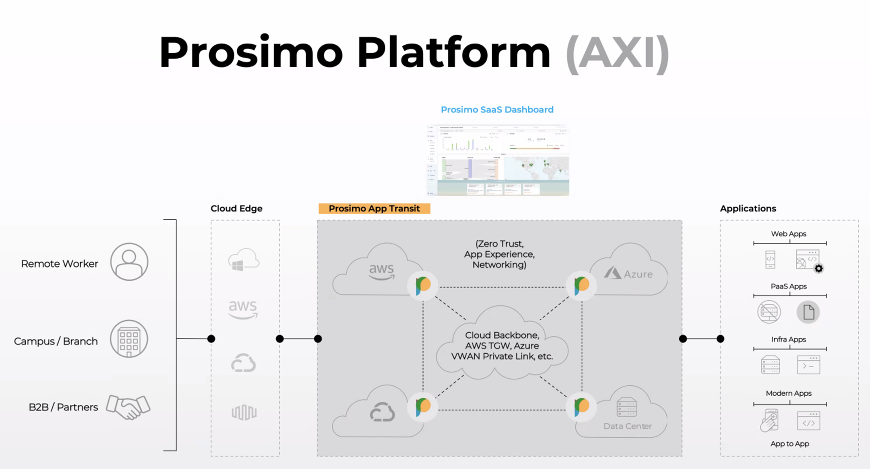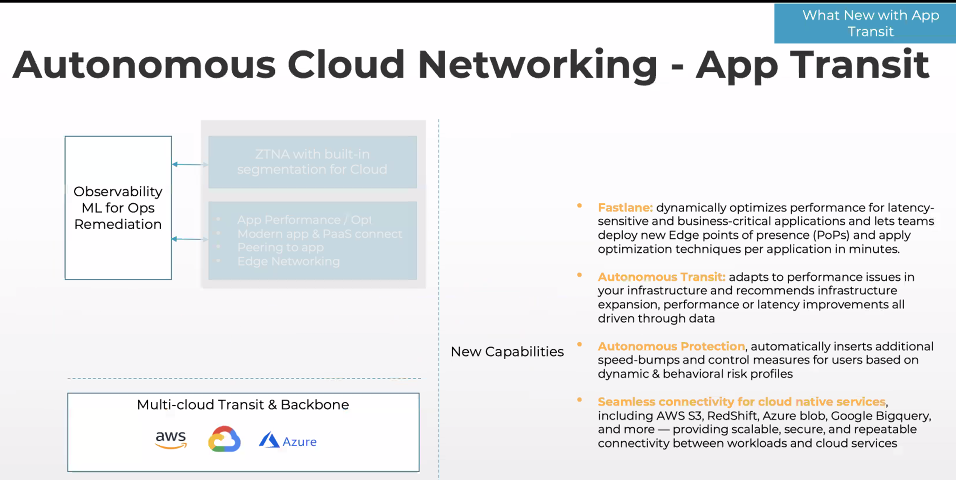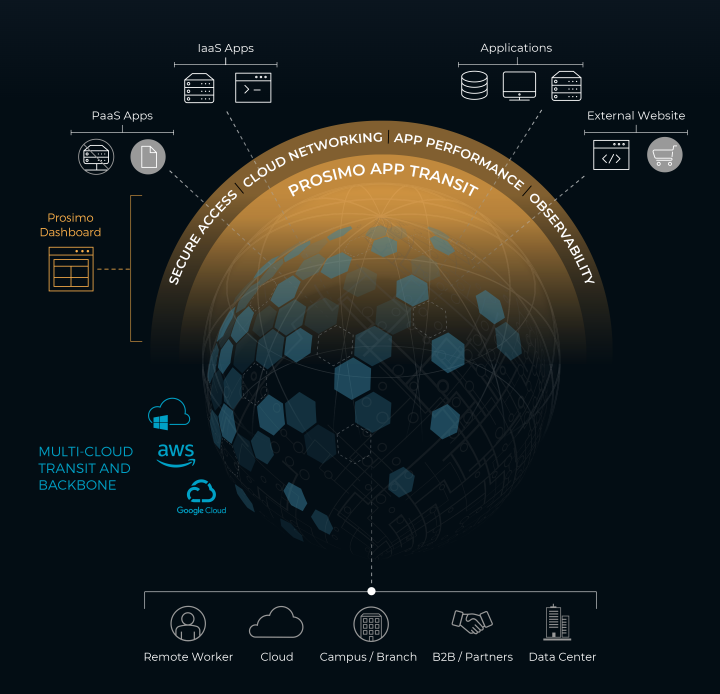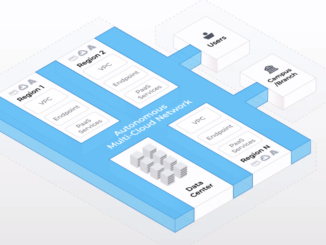
The enterprise rush to embrace multicloud and hybrid cloud has not slowed over the past several years and, indeed, has only accelerated during the COVID-19 pandemic as organizations rushed to leverage cloud services to adapt to their suddenly highly distributed IT environments, with most of their employees working remotely. And they’re sticking with this, given that the dramatic shift to a hybrid workforce seems for many to be permanent.
A mutlicloud strategy can bring myriad benefits to an enterprise, from greater flexibility and agility to avoiding being locked into a single cloud provider, allowing organizations to choose the right cloud for a particular workload and protecting itself if a cloud service goes down. However, it can also add its share of complexity and according to Prosimo, a key to ensuring application performance in such a distributed environment is a simplified multicloud networking setup.
Prosimo was founded in 2019 with this belief in mind, one that has only been reinforced by research the company has done. In a study released earlier this month, the company found that enterprises continue to see multicloud as a critical computing model going forward, with 62 percent of more than 400 IT leaders surveyed saying they have plans for a mature multicloud environment within two years. About 91 percent said they’d get there after two years.
One area that’s slowing down adoption is the lack of a comprehensive multicloud networking strategy, according to the study. Sixty-three percent of the IT leaders said a successful multicloud plan ensures consistency and security across users, applications and devices, but 53 percent said they can get there with traditional network approaches.
Prosimo was launched by the founders of Viptela, a player in the software-defined WAN (SD-WAN) space that was bought by Cisco Systems in 2017 for $610 million. Backed by $25 million in investment funds, in April it rolled out its Application eXperience Infrastructure (AXI) platform, which initially was designed to focus on combining networking, performance, security, observability and cost management into a single and integrated infrastructure stack, Mehul Patel, head of marketing at Prosimo, tells The Next Platform.
“These all go hand-in-hand, so why would you only focus on one outcome or one problem and then try to move yourself to fixing networking and then think about security?” Patel says. “[Prosimo] combines those four principles and gives customers a platform where they can start knocking out networking and as they’re doing networking, they can think about observability and performance and security each step of the way. That’s the overall goal of the company. That’s the outcome we want and all these should drive the outcome. The biggest outcome is delivering these applications. [The platform] allows you to measure security, value. It allows you to measure performance benefit. Those are some of the application outcomes that you get.”
The disparate nature of what is in the cloud also was a challenge, according to Mani Ganesan, the vendor’s head of product
“As different types of applications move to the cloud – whether a single cloud or multiple regions or multiple clouds – each application is different,” Ganesan tells The Next Platform. “We can’t treat all these applications with one broad-brush approach. An infrastructure application is different from a web application. Think of the problem in multiple layers. What does it mean for cloud transit? … The same thing with the users as well. Users are getting disparate – they’re partners, enterprise consumers, enterprise employees. They all come from different parts of the world. What does it mean for secure access? How do you ensure that all the [users, applications and devices] that are asking for access are all correct and then you can authorize and authenticate them and on a continuous basis? Also, what does that mean for performance, observability and so on?”
Prosimo recently expanded the features in the platform’s App Transit multicloud networking infratructure, including Fastlane, which helps organizations extend their reach more easily to the fast-growing edge. Fastlane accelerate the performance of latency-sensitive applications by enabling organizations to deploy edge points of presence (POPs) and to quickly apply optimization techniques for specific applications.
In addition, Autonomous Transit dynamically detects performance issues in application-to-application networks an enterprise’s infrastructure and adapts by recommending such steps as expanding the infrastructure or improving the performance or latency. Dynamic Compliance ensures compliance to requirements – either in the industry or through local and international regulations – by automatically inserting user measures based on dynamic and behavioral risk profiles.
Prosimo also is improving connectivity for cloud-native services, such as Amazon Web Services (AWS) S3 and Microsoft Azure Blog storage services and Amazon’s Redshift and Google’s BigQuery data warehouses.
In addition, the company is expanding its presence with the top public cloud services providers to enable enterprises to more easily adopt a cloud-native networking model. Prosimo is growing its relationship with AWS by making available a reference architecture in the cloud and offering AXI in the AWS Marketplace and Azure Marketplace. It also recently announced a partnership with Google Cloud to improve organizations’ cloud networks and the speed and security of applications at the edge.
Such partnerships with AWS, Azure, and Google Cloud dovetail with the multicloud ambitions that enterprises have had for several years and that arose again in Prosimo’s survey, which showed that 45 percent of respondents would have advanced multicloud capabilities now if there weren’t the networking and other challenges. Traditional networking approaches like VPNs and WAN don’t work well nearly as well as multicloud transit networking offering like Prosimo’s, which the company said the study shows reduces latency across 50 percent more paths than a single cloud alone and improves performance by up to 55 percent for routes.
“Now [enterprises are] thinking, ‘What does it mean for me building a multicloud network in transit? I have all these virtual clouds, or VCs, I need to think of. My application teams and my developer teams are asking to move faster. I have to connect new VCs and new regions, interconnect with all of them and all the users have to talk to each other,’” Ganesan says. “This is not a static environment anymore. This is more dynamic because of how cloud is set up, new apps coming up, new services getting spun down. There are very ephemeral kind of things. Containers pop up a lot more. If you are thinking, ‘Let’s talk about a legacy approach,’ let’s not think about the cloud problem as bringing virtual appliances that mix a bunch of routers, a bunch of firewalls, a bunch of load balancers, IP-based access list. That’s an old way. If you’re going down the path, you’re going to struggle. That may work well for the first few instances, maybe one region, but it’s going to fall apart the moment you are six months with the cloud.”








Be the first to comment